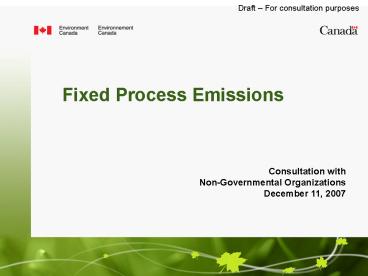Fixed Process Emissions PowerPoint PPT Presentation
1 / 9
Title: Fixed Process Emissions
1
Fixed Process Emissions
Consultation with Non-Governmental
Organizations December 11, 2007
2
Issue
- Implementing the fixed process emission
provisions in framework - Recalling from Framework that
- Predefined fixed process emissions would have a
0 reduction in emission intensity from 2006
levels in 2010 - Fixed process emissions are emissions that are
tied to production and for which there is no
alternative technology that will reduce them.
The only way to reduce these emissions is to
reduce production. - Fixed process emissions will have to be
determined on the basis of the characteristics of
firms and sectors.
3
What are fixed process emissions
- Most industrial GHG emissions are from
- Fuel combustion
- Burning of fossil fuels to produce energy
- Processes
- Chemical reactions in production processes or
other releases of GHGs during the production
process. - Differing ability to reduce emissions
- Fuel combustion emissions can be reduced through
fuel efficiency and the use of low emitting fuels - Some process emissions can be reduced through the
use of alternate processes and improved process
control. - Other process emissions are not controllable
- It is these process emissions that not
controllable with alternate technologies that are
considered fixed process emissions.
4
What are fixed process emissions Example
- Cement
- Cement is made by heating calcium carbonate
(CaCO3), found in limestone at high temperatures
to produce clinker (mainly calcium oxide) the
main ingredient of cement. - In the process as calcium carbonate converts to
calcium oxide (CaO), CO2 is released from the
calcium carbonate. - CaCO3? CaO CO2.
- CO2 is released at a rate of 0.44t CO2/t Clinker.
- Combustion is the other reaction releasing CO2 in
the process. - Heat from combustion is needed to drive the
reaction. This is not considered a fixed process
emission because it is intended to produce energy
for the process.
5
Fixed process emissions as estimated and
presented in Framework
Adapted from April 30, May 1, 2007 technical
briefings
6
Framework Background
- Estimates in Framework of fixed process emissions
(winter 2007) were based on previous work by the
departments. - Have generally followed a narrow interpretation
of what are fixed process emissions. - Recognizing the risk of slippage on emission
reductions if the interpretation is broadened. - Department consulted with industry in the spring
and summer of 2007 on fixed process emissions in
their sectors.
7
Status
- Designation as fixed process emission is based on
decision on whether facilities in that sector
have the potential to reduce the process emission
(for ex., through efficiencies, alternate
technologies etc). - Analysis is underway to confirm the specific
fixed processes in each sector.
8
Annex Initial list of fixed process emissions
- Iron Ore Pellets
- The calcination of limestone and dolomite added
to pellets as fluxing agents - Base Metals
- The calcination of limestone and dolomite used as
fluxing agents - Aluminum
- Hall-Héroult process electrolytic reduction of
alumina using carbon anodes - Aluminia
- No fixed processes
- Cement and Lime
- The calcination of limestone and dolomite
feedstocks
9
Annex Initial list of fixed process emissions
(cont.)
- Nitrogen Fertilizer
- Steam methane reforming to produce hydrogen used
to make ammonia - Titanium Dioxide
- Chloride process
- Petrochemical Industry (Ethylene oxide,
terephthalic acid, methanol, cyclohexanol etc) - Catalytic oxidation of hydrocarbons where 100
conversion to desired product is not possible due
to undesirable and uncontrollable side reactions - Oil Sands
- Steam methane reforming to produce hydrogen used
to upgrade bitumen - Petroleum Refining
- Steam methane reforming to produce hydrogen used
in refining process

